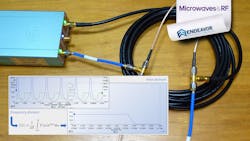Using a VNA Like a Time-Domain Reflectometer (Download)
Time-domain reflectometry (TDR) is a technique that measures and displays the impedance of a network (cable, filter, and so on) over time. Traditionally, this is done with a device that generates very fast pulses, injects them on the network, and measures the time and amplitude of reflected pulses.
TDR yields information about the impedance as a function of the time it takes for a pulse to reflect or travel through the medium. And, because the signals travel with (nearly) the speed of light, the time can be translated to a distance through a cable or network.
The same kind of measurement can be taken using a vector network analyzer (VNA), but in a roundabout way. A VNA measures the (reflected) impedance over frequency. We can use a Fourier transform to convert this into a series of impedances over time, just as that produced by a TDR instrument.
